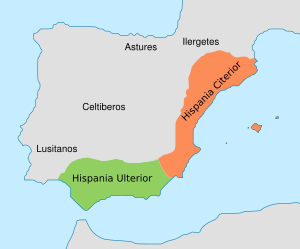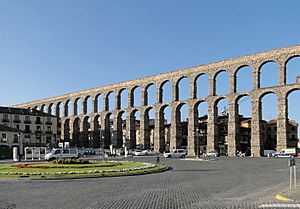Hispania Ulterior facts for kids
Quick facts for kids Hispania Ulterior |
|||||||
|---|---|---|---|---|---|---|---|
| Province of the Roman Republic | |||||||
| 197 BC–19 BC | |||||||
 Hispania Ulterior in 197 BC (in green) |
|||||||
| Capital | Corduba (Córdoba) | ||||||
| Historical era | Antiquity | ||||||
|
• Established
|
197 BC | ||||||
|
• Disestablished
|
19 BC | ||||||
|
|||||||
| Today part of | Spain Gibraltar Portugal |
||||||
Hispania Ulterior was an important area during the time of the Roman Republic. Its name means "Further Hispania" in English. This region covered a large part of what is now Spain and Portugal. It included areas like the Guadalquivir Valley and the land known today as Lusitania and Gallaecia. The main city, or capital, of Hispania Ulterior was Corduba.
Contents
What's in a Name? Hispania Ulterior Explained
The name Hispania was the Latin word for the Iberian peninsula. People used this term as early as 200 BC. Some think the word came from an ancient language called Punic. It might have meant "coast of hyraxes".
However, Phoenician explorers may have confused the many rabbits there with hyraxes. The word Ulterior means "that is beyond" or "further". So, Hispania Ulterior means "Further Hispania". An old historian named Cassius Dio said that many different tribes lived in this region. They did not all speak the same language or have the same government.
A Brief History of Hispania Ulterior
Rome's Expansion into Hispania
After losing some islands in the First Punic War, Carthage started to expand into the south of the Iberian peninsula. This led to the Second Punic War between Carthage and Rome. Much of this war happened in Hispania.
A Roman general named Scipio Africanus took control of Hispania from Hannibal and the Carthaginians. This happened after the Battle of Ilipa in 206 BC. Carthage finally gave up control of the region to Rome in 201 BC.
Dividing the Land: Hispania Citerior and Ulterior
In 197 BC, Rome divided the peninsula into two provinces. This was because two Roman armies were needed to conquer the area. These two new regions were Hispania Citerior (Nearer Hispania) and Hispania Ulterior (Further Hispania).
The border between them generally ran from Carthago Nova to the Cantabrian Sea. Hispania Ulterior included what is now Andalusia, Portugal, Extremadura, and parts of Castilla y León, Galicia, Asturias, Cantabria, and the Basque Country.
Rebellions and Roman Conquest
The region was peaceful until 155 BC. Then, the Lusitanians attacked Hispania Ulterior. They defeated Roman leaders twice. Their success caused other rebellions across the peninsula.
The Iberian peninsula became a place for Roman leaders to gain fame and wealth. A Roman consul named Decimus Junius Brutus Callaicus largely conquered the area in 138 BC. But fighting continued for many years.
Finally, in 19 BC, Agrippa defeated the Cantabrians in Hispania Citerior. This meant all of Hispania was now under Roman control.
Reorganizing the Provinces
In the same year, the Roman Emperor Augustus reorganized the provinces. Hispania Ulterior was divided into two new provinces: Baetica (modern Andalusia) and Lusitania (modern Portugal, Extremadura, and part of Castilla-León). Hispania Citerior was renamed Hispania Tarraconensis. It now included Cantabria and the Basque Country.
The End of Roman Rule
In the early 400s AD, a group called the Vandals invaded and took over southern Hispania. The Roman Emperor Honorius asked the Visigoth king, Athaulf, for help. The Visigoths took control of Hispania and made Toledo their capital.
How Rome Changed Hispania
Each Roman province was ruled by a leader called a praetor. Important local people from Hispania were allowed to join the Roman upper class. They could even help govern their own areas.
Three Roman emperors were born in Hispania: Trajan, Hadrian, and Theodosius I. Large Roman farms, called latifundia, were given to wealthy Romans throughout the region. Cities like Valencia were improved. Romans also built amazing irrigation systems, like aqueducts, to bring water to cities and farms.
The economy of Hispania grew strong. It became a major producer of grain. It also exported gold, olive oil, wool, and wine to other parts of the Roman Empire.
See also
 In Spanish: Hispania Ulterior para niños
In Spanish: Hispania Ulterior para niños
- Pre-Roman peoples of the Iberian Peninsula


